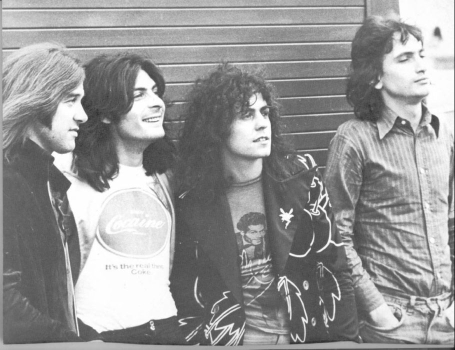T. Rex and glam rock
Bolan and his producer Tony Visconti oversaw the session for "Ride a White Swan", the single that changed Bolan's career which was inspired in part by Mungo Jerry's success with "In the Summertime", moving Bolan away from predominantly acoustic numbers to a more electric sound. Recorded on 1 July 1970 and released later that year, it made slow progress in the UK Top 40, until it finally peaked in early 1971 at number two.
Bolan took to wearing top hats and feather boas on stage as well as putting drops of glitter on each of his cheekbones. Stories are conflicting about his inspiration for this—some say it was introduced by his personal assistant, Chelita Secunda, although Bolan told John Pidgeon in a 1974 interview on Radio 1 that he noticed the glitter on his wife's dressing table prior to a photo session and casually daubed some on his face there and then. Other performers—and their fans—soon took up variations on the idea.
The glam era also saw the rise of Bolan's friend David Bowie, whom Bolan had come to know in the underground days (Bolan had played guitar on Bowie's 1970 single "Prettiest Star"; Bolan and Bowie also shared the same manager, Tony Howard, and producer, Tony Visconti)
Bolan followed "Ride a White Swan" and T. Rex by expanding the group to a quartet with bassist Steve Currie and drummer Bill Legend, and cutting a five-minute single, "Hot Love", with a rollicking rhythm, string accents and an extended sing-along chorus inspired somewhat by "Hey Jude". It was number one for six weeks and was quickly followed by "Get It On", a grittier, more adult tune that spent four weeks in the top spot. The song was renamed "Bang a Gong (Get It On)" when released in the United States, to avoid confusion with another song of the same name by the American band Chase. The song reached No. 10 in the United States in early 1972, the only Top 40 single the band had in America.
In November 1971, the band's record label, Fly, released the Electric Warrior track "Jeepster" without Bolan's permission. Outraged, Bolan took advantage of the timely lapsing of his Fly Records contract and left for EMI, who gave him his own record label, the T. Rex Wax Co. Its bag and label featured an iconic head-and-shoulders image of Bolan. Despite the lack of Bolan's endorsement, "Jeepster" peaked at number two.
In 1972, Bolan achieved two more British number ones with "Telegram Sam" and "Metal Guru" (the latter of which stopped Elton John getting to the top with "Rocket Man") and two more number twos in "Children of the Revolution" and "Solid Gold Easy Action". Bolan told Gloria Jones the track "Metal Guru" would be "the smoothest song in history".
In the same year he appeared in Ringo Starr's film Born to Boogie, a documentary showing a concert at Wembley Empire Pool on 18 March 1972. Mixed in were surreal scenes shot at John Lennon's mansion in Ascot and a session with T. Rex joined by Ringo Starr on second drum kit and Elton John on piano. At this time T. Rex record sales accounted for about 6 percent of total British domestic record sales. The band was reportedly selling 100,000 records a day; however, no T. Rex single ever became a million-seller in the UK, despite many gold discs and an average of four weeks at the top per Number One hit.
In 1973, Bolan played twin lead guitar alongside his friend Jeff Lynne on the Electric Light Orchestra songs "Ma-Ma-Ma Belle" and "Dreaming of 4000" (originally uncredited) from On the Third Day, as well as on "Everyone's Born To Die", which was not released at the time but appears as a bonus track on the 2006 remaster.
Bolan played guitar on the track "Have You Seen My Baby (Hold On)" on Ringo Starr's album Ringo.
By late 1973, his pop star fame gradually began to wane, even though he achieved a number three hit, "20th Century Boy", in February and mid-year "The Groover" followed it to number four. "Truck On (Tyke)" missed the UK Top 10 reaching only No. 12 in December. However, "Teenage Dream" from the 1974 album Zinc Alloy and the Hidden Riders of Tomorrow showed that Bolan was attempting to create richer, more involved music than he had previously attempted with T. Rex. He expanded the line up of the band to include a second guitarist, Jack Green, and other studio musicians, and began to take more control over the sound and production of his records, including by then girlfriend Gloria Jones on keyboards as well as backing vocals.
In 1974, Bolan played guitar for Ike & Tina Turner. He appeared on "Sexy Ida (Part II)", and "Baby Get It On". Tina Turner confirmed this in a BBC Radio 1 interview.
Eventually, the vintage T. Rex line-up disintegrated. Legend left in 1973 and Finn in 1975 and Bolan's marriage came to an end because of his affair with backing singer Gloria Jones who bore his son Rolan on 26 September 1975. He spent a good deal of his time in the US during this period, continuing to release singles and albums which, while less popular to the masses, were full of unusual lyrics and sometimes eccentric musical experiments. Although Bolan's health began to fail as he put on weight, the former glam rock icon cleaned up and continued working, producing at least one album every year.
Trex as the original line up
